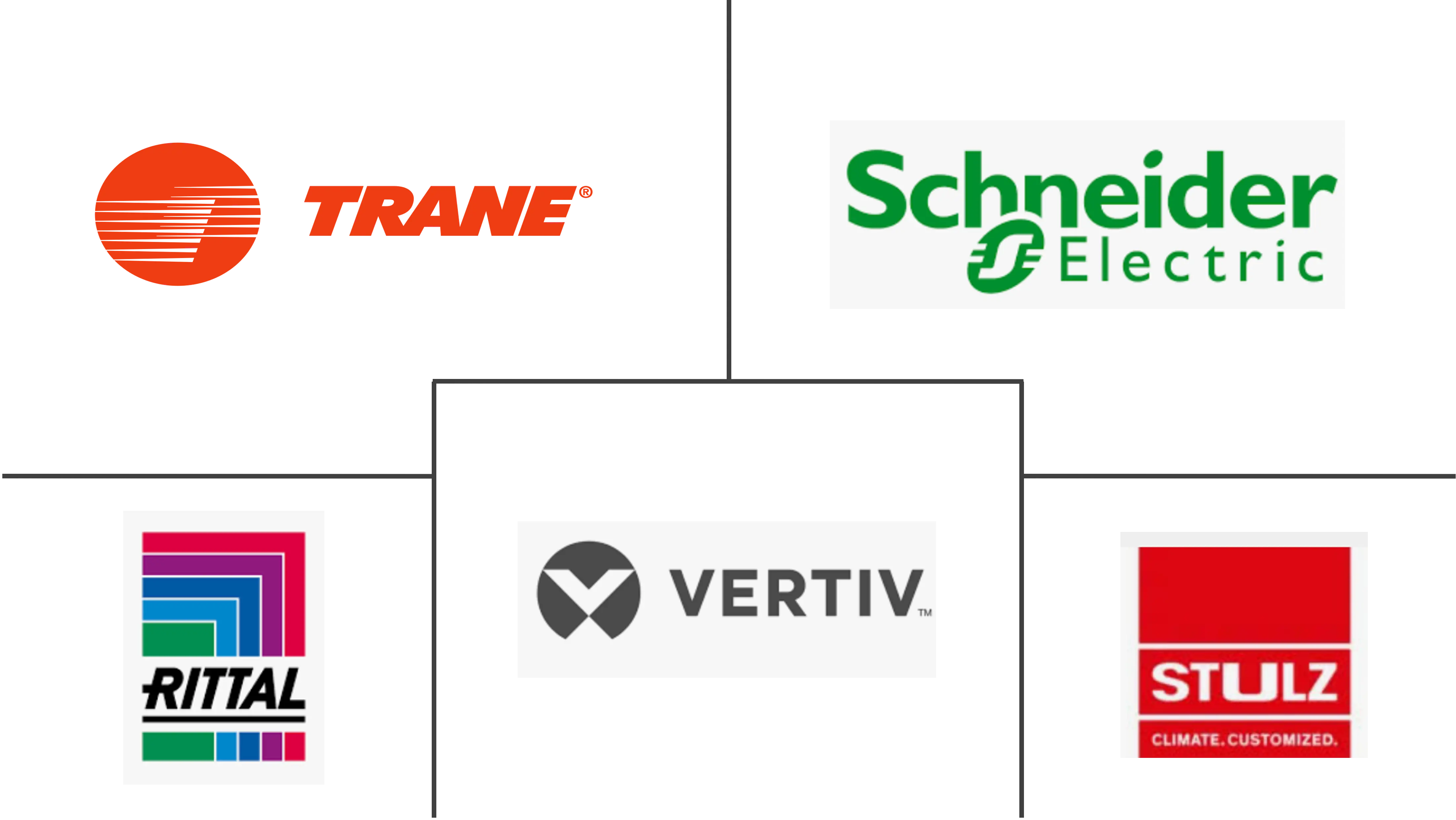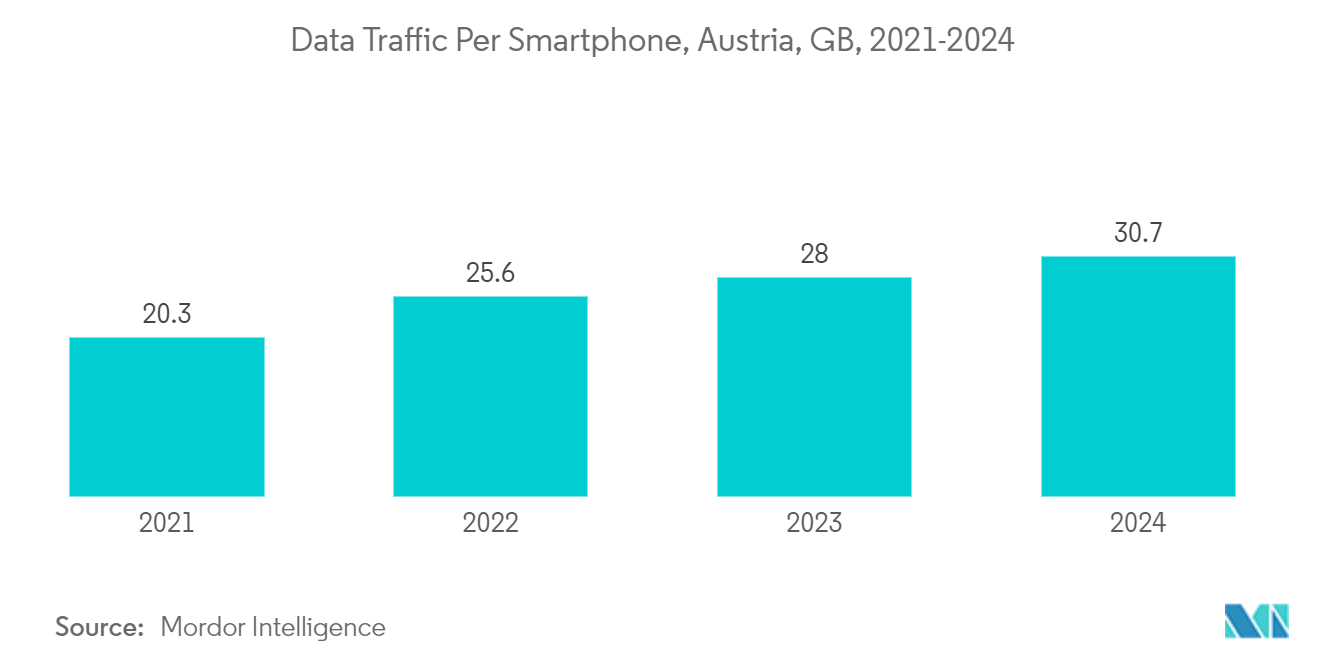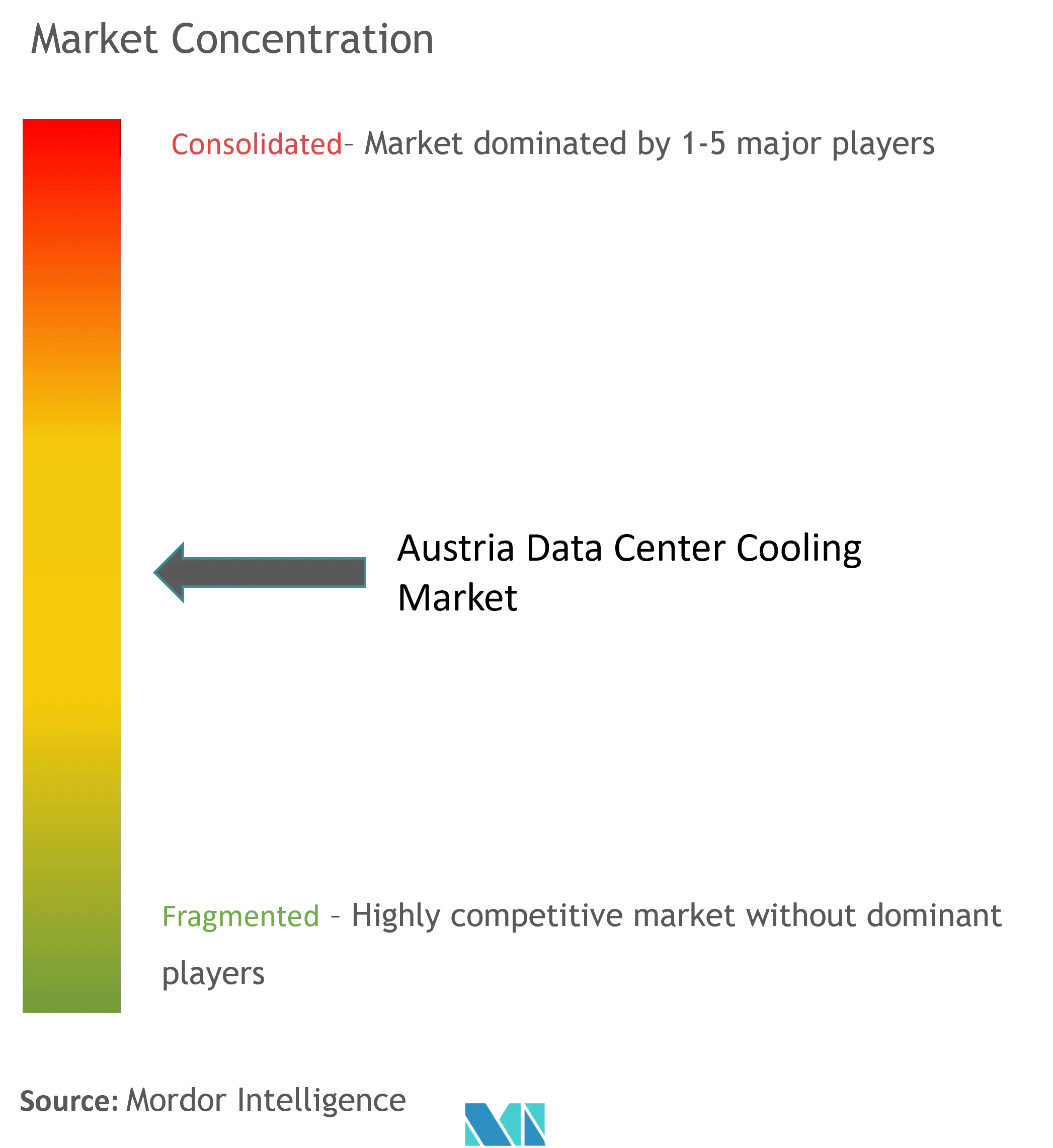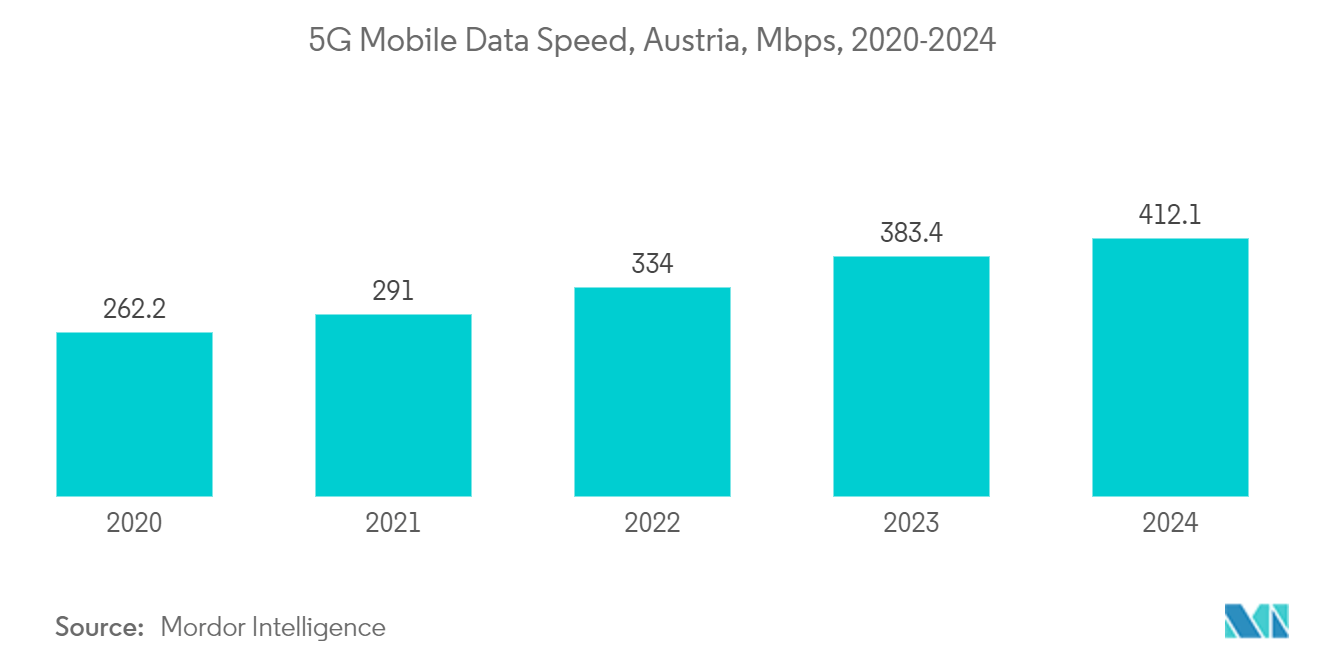
| Study Period | 2019 - 2031 |
| Base Year For Estimation | 2024 |
| Forecast Data Period | 2025 - 2031 |
| Market Size (2025) | USD 45.71 Million |
| Market Size (2031) | USD 100.50 Million |
| CAGR (2025 - 2031) | 14.03 % |
| Market Concentration | High |
Major Players
*Disclaimer: Major Players sorted in no particular order |
Austria Data Center Cooling Market Analysis
The Austria Data Center Cooling Market size is estimated at USD 45.71 million in 2025, and is expected to reach USD 100.50 million by 2031, at a CAGR of 14.03% during the forecast period (2025-2031).
- In Vienna, the summers are warm, the winters are very cold, and it is partly cloudy year-round. Over the year, the temperature typically varies from -2.7°C to 26°C. While natural cooling with river water plays a key role in Austria's eco-sustainability, the required non-stop cooling capacity is majorly being ensured by mechanical means such as chillers.
- The upcoming IT load capacity of the Austrian data center market is expected to reach more than 200 MW by 2030. The country's construction of raised floor area is expected to increase to more than 600 K million sq. ft by 2030.
- The country's total number of racks to be installed is expected to reach more than 31 K units by 2030. Vienna is expected to house the maximum number of racks by 2030. Currently, there are no submarine cable systems connecting Austria.
- In terms of development, in July 2023, Anritsu Corporation introduced the Coherent OTDR MW90010B to locate faults in submarine cables. MW90010B can evaluate up to 20,000 km and has an easily selectable wavelength that covers the full C-band. It is more portable, with a 40% weight reduction for the same product size as the previous model.
Austria Data Center Cooling Market Trends
IT and Telecom to Hold Significant Share
- The market is driven by the expanding adoption of the 5G network. The telecommunication industry is poised to maintain its leading position. Austria, a compact nation with a populace of 8.9 million, has emerged as a frontrunner in the 5G arena. Austrian operators aim to set up 5G networks along key data traffic routes by the close of 2023, with aspirations for nationwide 5G coverage by the end of 2025. These developments indicate a surge in data speeds and an escalating demand for data center servers.
- As Austria leans into digitization, businesses are increasingly turning to cloud services. For instance, in October 2023, CloudCamp4SMEs rolled out a dedicated Cloud Training Program for Small and Medium-sized Enterprises (SMEs) in the European Union (EU) to enhance their digital transformation efforts. Moving forward, CloudCamp4SMEs intends to broaden its European footprint, collaborating with additional training providers and business associations to strengthen its impact on boosting digital skills among SMEs across the country.
- The IT industry is among the fastest-growing markets in the technology sector, fueled by constant evolution and the annual emergence of new trends. The urgency for firms to adopt digital operations was highlighted by the COVID-19 pandemic. As a result, more businesses are seeking external expertise for swift, modern, and innovative technology solutions. For instance, the Ö-Cloud initiative promotes secure data management and utilization within companies. In line with this, there's a movement for domestic cloud providers to integrate into a unified digital security network. In Austria, cloud service providers conduct thorough self-evaluations against strict, transparent security standards. The "Ö-Cloud" seal, awarded by the "Eurocloud" association of the Austrian Cloud Computing Industry, validates adherence to these standards. This seal guarantees customers that their data is securely managed within Austria or Europe and safeguarded against misappropriation. Such assurances build trust between companies and their customers, paving the way for increased cloud service adoption in the coming years.
- In 2023, more than 63% of companies in Austria are actively utilizing cloud solutions. Additionally, over 86% of these cloud adopters attribute a significant role to the Cloud in their company's digitization journey. Looking forward, more than 50% of respondents predict that by 2025, they will primarily run their productive applications from the Cloud. This rising demand for cloud services, alongside infrastructure enhancements, is driving a notable surge in the need for managed IT services in the foreseeable future.
Liquid Cooling to Hold Significant Growth
- Direct-to-chip liquid cooling enables efficient cooling and heat dissipation for performance-demanding servers. This method ensures peak system performance and reliability and promotes denser computing. In facilities with exceptionally high-density racks (typically exceeding 30 kW), air cooling falls short, failing to maintain the reliability of IT systems, no matter how new or optimized. Given these challenges, liquid cooling emerges as the superior choice. Notably, under-construction facilities like Interxion's VIE3 and STACKIT's Ostermiething (AT) DC 10 Phase 2 are designed with high rack density in mind.
- Austria is at the forefront of driving the Industry 4.0 movement, leading numerous large-scale initiatives, often in partnership with global OEMs. For instance, in February 2024, the BMW Group Plant in Steyr was awarded the esteemed INDUSTRIE 4.0 AWARD. Central to Steyr's digital evolution is the InnoLab, a dedicated hub for testing new applications, which are subsequently integrated into production if found advantageous. A digitalization map highlights the active digital solutions in play. Currently, around 200 varied projects are in motion, ranging from fundamental data visualizations to complex AI solutions across multiple production lines. A standout is the use of generative AI for AI-driven quality control of components. Given the magnitude of these endeavors, the region is poised for a heightened demand for data storage and computational facilities. This uptick signals a growing need for data centers in Austria, subsequently driving an increased reliance on cooling systems to manage heat within these centers.
- Moreover, the surge of OTT platforms and streaming services has resulted in a significant uptick in data volumes, a trend expected to drive demand further. The swift expansion of cloud services, the rising significance of big data, and the deeper integration of connected devices are prompting organizations to ramp up investments in new data center facilities. For example, in May 2024, A1 Group's International Business division rolled out a business-to-business white-label OTT platform in the Cloud. These developments are set to amplify the demand for data center cooling systems in Austria.

Austria Data Center Cooling Industry Overview
The Austrian data center cooling market exhibits a moderate level of consolidation among key industry players, having sharpened their competitive edge in recent years. Notable market leaders in this segment include Trane Technologies Company LLC, STULZ AUSTRIA Gesellschaft mbH, Schneider Electric SE, Vertiv Group Corp., and Rittal GMBH & Co.KG. These industry giants, boasting significant market shares, are actively engaged in expanding their customer base throughout the region. Their growth strategies primarily hinge on strategic collaborative efforts aimed at enhancing market share and overall profitability. Moreover, companies such as Schneider Electric SE, Vertiv Group Corp., and Rittal GMBH & Co.KG offer both liquid and air-based cooling products.
Austria Data Center Cooling Market Leaders
-
Stulz GmbH
-
Rittal GMBH & Co.KG
-
Schneider Electric SE
-
Vertiv Group Corp.
-
Trane Technologies Company, LLC
- *Disclaimer: Major Players sorted in no particular order

Austria Data Center Cooling Market News
- July 2024: In Vienna, Austria, a data center in the Floridsdorf neighborhood turned data into warmth for a nearby public hospital. In collaboration with regional energy provider Wien Energie, Digital Realty's facility employed a heat pump system to supply heat to Klinik Floridsdorf Hospital, located just 150 m (490 ft) away.
- November 2023: EkkoSense appointed Artur Faust as the DACH Sales Manager, spearheading the company's expansion into the German, Austrian, and Swiss markets. EkkoSense's EkkoSoft Critical, an AI-driven optimization software, promises measurable reductions in cooling energy consumption, complemented by automated ESG reporting features.
Austria Data Center Cooling Industry Segmentation
Data center cooling is a set of techniques and technologies to maintain optimal operating temperatures in data center environments. Data center cooling is critical as data center facilities house many computer servers and network equipment that generate heat during operation. Efficient cooling systems are used to dissipate this heat and prevent equipment from overheating, ensuring continued reliable operation of the data center. Various methods, such as air conditioning, liquid cooling, and hot/cold aisle containment, are commonly used to control temperature and humidity in data centers.
The Austrian data center cooling market is segmented into technology (air-based cooling [chillers and economizers, CRAH, cooling towers, and other air-based cooling technologies] and liquid-based cooling (immersion cooling, direct-to-chip cooling, and rear-door heat exchanger]), type of data center (hyperscaler, enterprise, and colocation), and end-user industry (IT and telecom, retail and consumer goods, healthcare, media and entertainment, federal and institutional agencies, and other end-user industries). The market sizes and forecasts are provided in terms of value (USD) for all the above segments.
| By Cooling Technology | Air-based Cooling | Chiller and Economizer | |
| CRAH | |||
| Cooling Tower (covers direct, indirect & two-stage cooling) | |||
| Others | |||
| Liquid-based Cooling | Immersion Cooling | ||
| Direct-to-Chip Cooling | |||
| Rear-Door Heat Exchanger | |||
| By Type | Hyperscalers (owned & Leased) | ||
| Enterprise (On-premise) | |||
| Colocation | |||
| By End user Vertical | IT & Telecom | ||
| Retail & Consumer Goods | |||
| Healthcare | |||
| Media & Entertainment | |||
| Federal & Institutional agencies | |||
| Other end-users | |||
Austria Data Center Cooling Market Research FAQs
How big is the Austria Data Center Cooling Market?
The Austria Data Center Cooling Market size is expected to reach USD 45.71 million in 2025 and grow at a CAGR of 14.03% to reach USD 100.50 million by 2031.
What is the current Austria Data Center Cooling Market size?
In 2025, the Austria Data Center Cooling Market size is expected to reach USD 45.71 million.
Who are the key players in Austria Data Center Cooling Market?
Stulz GmbH, Rittal GMBH & Co.KG, Schneider Electric SE, Vertiv Group Corp. and Trane Technologies Company, LLC are the major companies operating in the Austria Data Center Cooling Market.
What years does this Austria Data Center Cooling Market cover, and what was the market size in 2024?
In 2024, the Austria Data Center Cooling Market size was estimated at USD 39.30 million. The report covers the Austria Data Center Cooling Market historical market size for years: 2019, 2020, 2021, 2022, 2023 and 2024. The report also forecasts the Austria Data Center Cooling Market size for years: 2025, 2026, 2027, 2028, 2029, 2030 and 2031.
Our Best Selling Reports
Austria Data Center Cooling Industry Report
Statistics for the 2025 Austria Data Center Cooling market share, size and revenue growth rate, created by Mordor Intelligence™ Industry Reports. Austria Data Center Cooling analysis includes a market forecast outlook for 2025 to 2031 and historical overview. Get a sample of this industry analysis as a free report PDF download.





